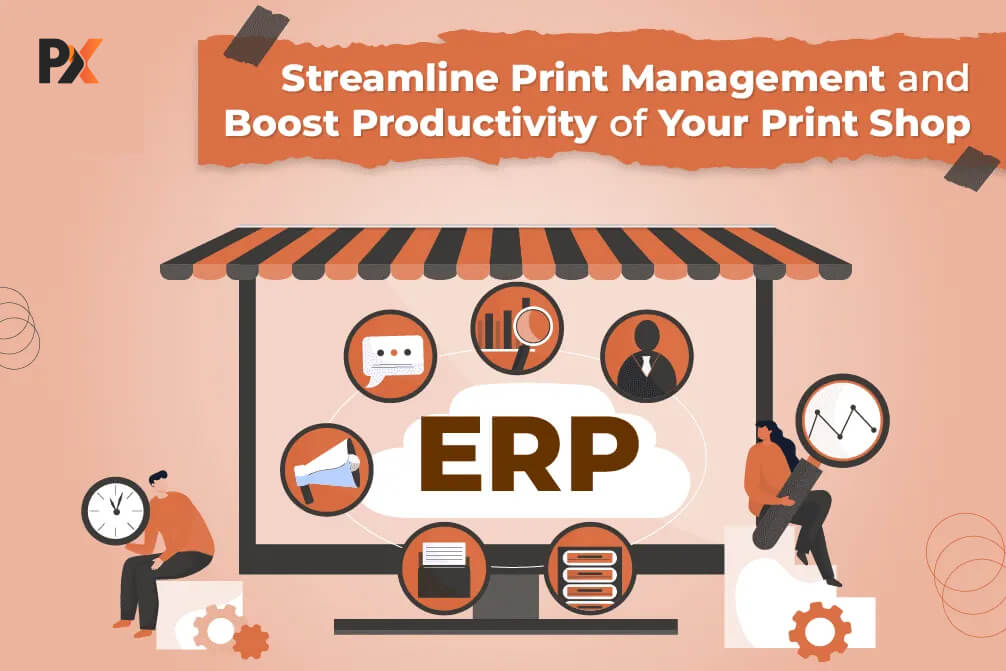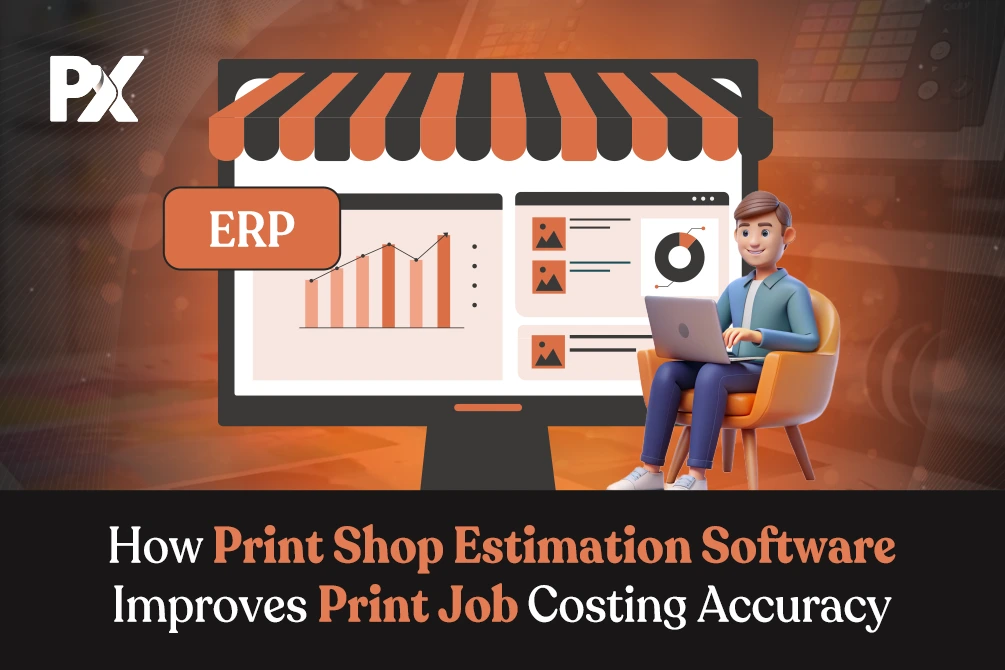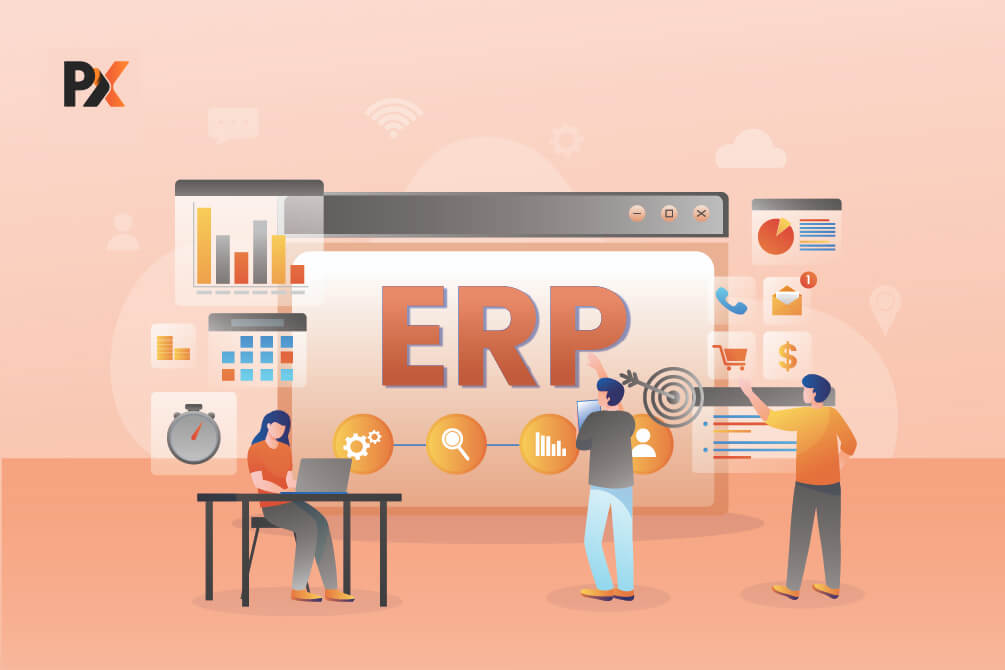Summary
Running a print shop can be tough, especially as your business grows.
You need to manage orders and workflows and meet client demands effectively.
Imagine a situation where a client urgently requires a large batch of customized materials. You want everything to be perfect and delivered on time.
But here’s the problem: your current methods of managing orders and communication can cause delays and confusion. Doing everything manually can lead to errors and dissatisfied customers.
That’s where the print management solution comes in to save the day.
By using print shop management software, you can say goodbye to manual processes and embrace automation in your print shop. It brings everything together in one system, from order processing to finishing.
So even if you receive a last-minute customization order, you can complete it timely with streamlined print management.
From checking inventory to getting artwork approval, generating quotes, and assigning jobs, everything becomes smooth and efficient.
Your order will be ready for delivery on time, without any hassle.
In this blog, we will explore the benefits of print management solutions for your print shop.
We’ll also guide you through the process of implementing this print management system, helping you optimize your print operations and make the most of its features.
Benefits of print management software
Implementing a print management solution or ERP solution can greatly simplify and streamline the print management of your shop.
Here are some benefits and features to consider:
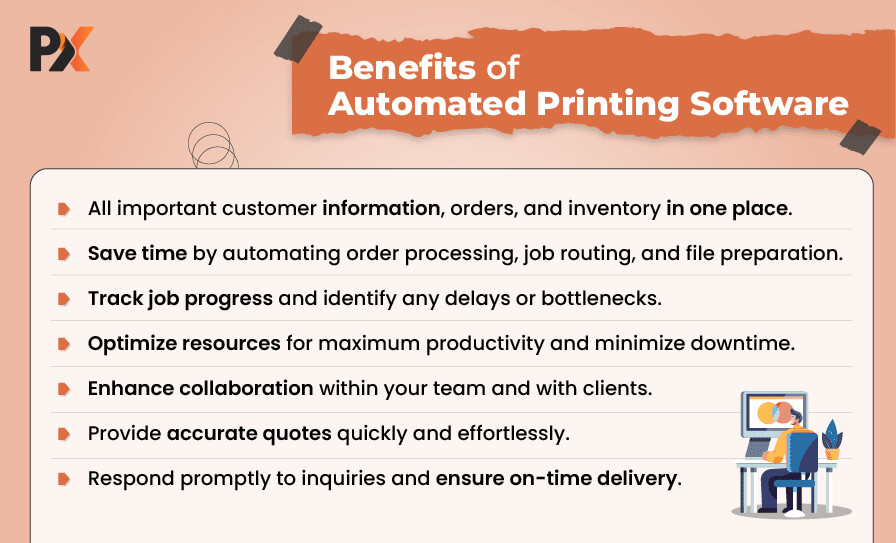
- Centralized data management: Say goodbye to the days of searching through multiple systems and spreadsheets. You can get all your important customer information, orders, and inventory in one convenient place. It saves you time and effort by providing easy access to the information you need, allowing you to efficiently manage your print shop.
- Automation of tasks: Imagine freeing up your time from repetitive manual tasks. You can automate various processes like order processing, job routing, and file preparation. By automating these tasks, you’ll save valuable time and reduce the chances of errors, enabling you to focus on more important aspects of your print shop.
- Better workflow visibility: Stay on top of your print shop’s workflow with ease. You can get a clear view of your workflows and job status, allowing you to track the progress of each job. You can quickly identify any delays or bottlenecks and make informed decisions to ensure smooth operations and timely deliveries.
- Efficient resource allocation: Optimize your resources for maximum productivity. The automated printing software helps you effectively allocate your inventory, manage stock levels, and ensure you have the right equipment and personnel for each job. This minimizes downtime, reduces wastage, and maximizes your print shop’s overall efficiency.
- Improved communication: Enhance collaboration and communication within your team and with your clients. The Web to Print MIS/ERP facilitates easy sharing of project updates, artwork proofs, and job specifications, ensuring everyone is on the same page. This promotes better coordination, reduces misunderstandings, and boosts teamwork.
- Streamlined quoting and estimation: Provide accurate quotes and estimates quickly and effortlessly. You can input job specifications, material costs, and other factors to generate precise quotes for your clients. This enables you to offer competitive pricing, win more business, and improve your profitability.
- Enhanced customer service: Delight your customers and exceed their expectations. With centralized customer information and real-time job tracking, you can respond promptly to inquiries, provide updates on job progress, and ensure on-time delivery. This level of service builds trust, strengthens customer relationships, and helps you stand out in a competitive market.
Boost your print shop’s efficiency and productivity with Web to Print MIS/ERP PrintXpand, a print management solution by PrintXpand. Discover how it can revolutionize your business.
Features to Look for in Print Management Software:
When choosing an automated printing software, there are several key features to consider that can greatly enhance your print order management:
- Compatibility and Integration: Ensure that the print shop management software is compatible with your existing hardware and software systems. It should seamlessly integrate with your current setup, allowing for a smooth transition and avoiding any compatibility issues.
- Scalability and Flexibility: Look for an automated printing software that can grow with your business and adapt to changing needs. It should be flexible enough to accommodate different types of print devices and handle increasing volumes of print jobs as your business expands.
- Workflow Automation: Choose print shop management software that allows you to automate manual tasks and provide streamlined print management. Look for features such as inventory management, artwork proofing, quote generator, etc., to save time and reduce errors in print order management.
- Reporting and Analytics: A good print management software should provide comprehensive reporting and analytics capabilities. It should allow you to track and analyze important metrics like print volumes, job statuses, and resource utilization. These insights can help you identify bottlenecks, optimize workflows, and make informed business decisions.
- Print Job Management: Look for features that enable effective print jobs management, such as job tracking, scheduling, and prioritization. The Web to Print MIS/ERP should provide a centralized dashboard where you can monitor the progress of each print job, assign tasks to specific employees or departments, and ensure timely completion.
- Cost Tracking: Consider print shop management software that offers robust cost tracking and billing capabilities. It should allow you to track printing costs for individual jobs, clients, or departments, and generate accurate invoices or cost reports. This helps you analyze and allocate costs, improving cost efficiency and profitability.
- Seamless Third-Party Integration: Look for a solution that seamlessly integrates with third-party applications and services you already use in your print shop. Whether it’s your accounting software, design tools, or customer relationship management system, the software should work harmoniously with your existing setup. This integration eliminates the hassle of switching between different systems and allows for a streamlined workflow.
How to Implement Print Management Software in Your Print Shop?
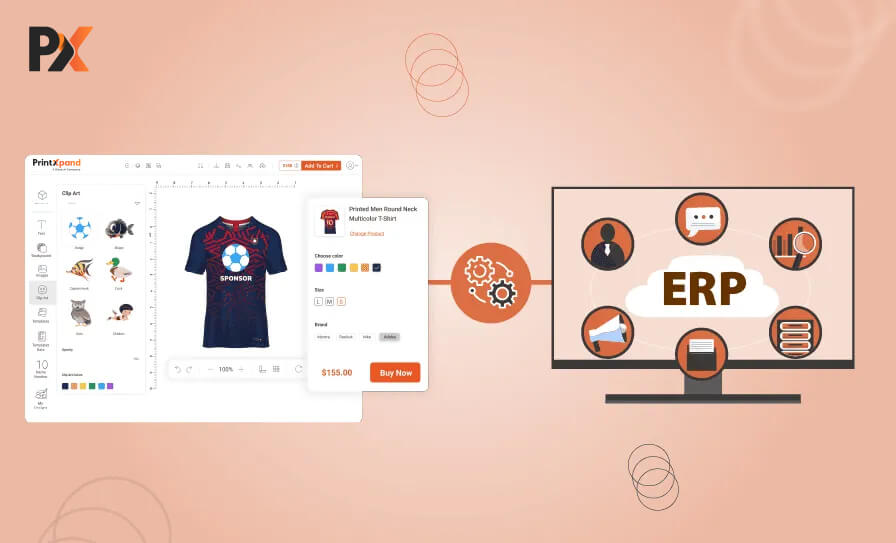
We follow a streamlined process to implement print order management software in your print shop, ensuring smooth integration and improved operations.
Step 1: Firstly, we upload your existing print job information, such as customer details, job specifications, and order data, into the software. This centralizes your data and makes it easily accessible for efficient print order management
Step 2: Next, we provide comprehensive training for you and your staff on using the print shop management software. This includes navigating the user interface and performing key tasks like job creation, scheduling, and tracking. The software facilitates the approval process for artwork and quote generation. You can easily share digital artwork, receive feedback, make revisions, and gain approval from clients before proceeding with production.
Step 3: Once the print ERP solution is in place, we work together to define the stages of your print job workflow for different products, such as printing, file cutting, embossing, finishing, delivery, etc. This ensures standardized print order management and boosts efficiency in your print shop.
Step 4: With workflow and materials management established, the print shop management software enables the generation of jobs based on the availability of manpower and machines. This optimizes resource allocation and ensures tasks are scheduled appropriately, minimizing delays and maximizing productivity.
Step 5: QR codes or tickets are generated for each job, to track job progress and enable smooth transitions. These codes serve as identifiers and can be easily scanned to update the job status and move it to the next stage in the workflow.
Thus, with just a couple of steps, you can achieve streamlined print management from the moment you receive an order until its delivery.
Ready to streamline your print operations?
Contact us now to implement print management software and optimize your workflow from order to delivery.
Common Challenges Faced by Print Houses and How Print MIS Helps Overcome Them:
Print houses face various challenges that can affect their efficiency. Let’s explore these challenges and see how implementing automated printing software can help overcome them.
Challenge 1: Standardize and Automate Processes:
Standardizing and automating print order management is important to ensure consistency, reduce errors, and save time. This means creating clear and consistent workflows for file preparation, proofing, printing, finishing, and delivery tasks. By implementing automated printing software, you can simplify job routing, file preparation, and imposition, making the workflow smoother and reducing manual errors.
Challenge 2: Optimize Print Job Workflow:
Analyzing your current workflow can help identify bottlenecks and unnecessary steps that slow down the process. By streamlining the workflow, removing unnecessary steps, and improving handoffs between stages, you can make print order management more efficient. Print management systems that offer job tracking and monitoring features give you real-time visibility into job progress, allowing you to promptly address any issues.
Challenge 3: Efficient Resource Management:
It’s important to schedule jobs effectively, minimize idle time, and maximize output to make the most of your printing equipment. Regular maintenance and servicing of your equipment can prevent unexpected breakdowns and minimize downtime. Keeping track of consumables and supplies ensures timely reordering and avoids delays. Print management solutions with intelligent scheduling algorithms can help optimize job sequencing and resource allocation, reducing idle time and improving efficiency.
Challenge 4: Enhance Communication and Collaboration:
Open communication channels and effective collaboration among team members is crucial for a print shop’s success. Implementing project management tools can help assign tasks, track progress, and encourage collaboration. By offering client portals, you can simplify the job submission and approval process for customers, improving communication and customer satisfaction.
Challenge 5: Continual Improvement and Performance Measurement:
Setting performance indicators and regularly reviewing performance data allows you to measure the success of your print shop. By analyzing the data, you can identify areas for improvement and make the necessary changes to streamline print management and optimize resource utilization. Encouraging your team to participate in improvement initiatives and fostering a culture of continuous improvement will contribute to enhanced productivity and quality.
Integrate an ERP and Unlock Business Growth Potential
In this blog, you have discovered how a print ERP can effectively address some of your print shop’s major challenges.
However, integrating an ERP is a significant decision that requires careful consideration.
Luckily, with over a decade of experience, PrintXpand is here to assist you every step of the way.
Our team understands the unique needs of your business and can provide you with a personalized demo of our print ERP solution. This firsthand experience will how our software can revolutionize your print shop operations.
Additionally, we provide you with a thorough training process that ensures a seamless transition from manual to automated workflows. Our experts will guide you and your staff, empowering you with the knowledge and skills needed to maximize our print ERP solution.
So, don’t hesitate to take the next step towards growth and efficiency.
All product and company names are trademarks™, registered® or copyright© trademarks of their respective holders. Use of them does not imply any affiliation with or endorsement by them.
